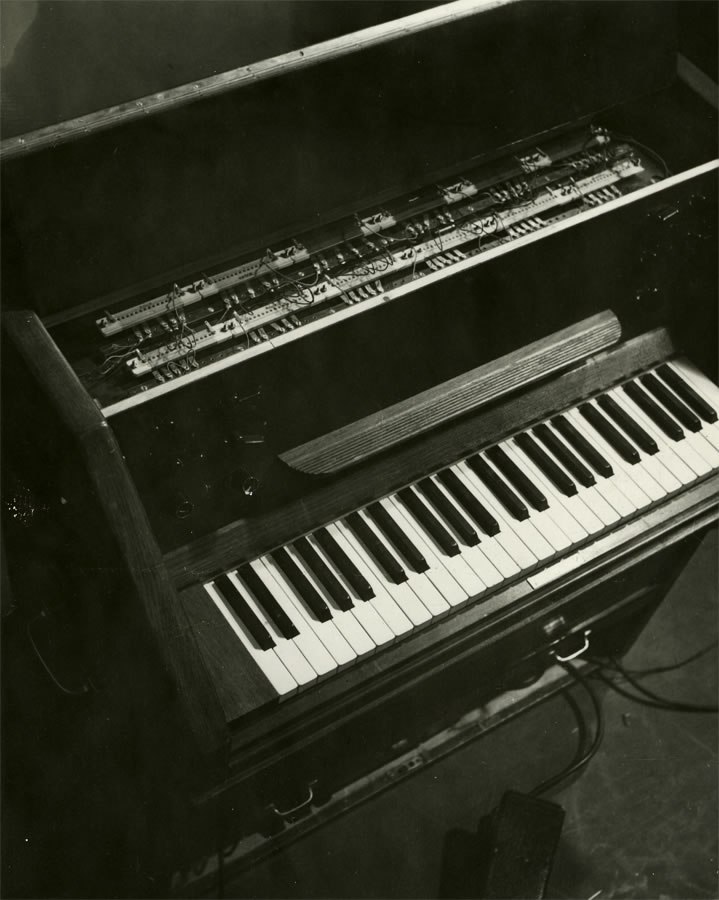Filter on ALL, SYNTH, DRUM, SAMPLER or MISC |
Total list currently 2405 items in 330 Brands |
Harald Bode | Melodium |
Description | Inventor Harald Bode created a monophonic touch sensitive keyboard instrument, the ‘Melodium’, developed with the assistance of Oskar Vierling, inventor of the ‘Grosstonorgel’. The instrument was used extensively for film music and ‘light music’ during the 1940’s. The articulation on the Melodium has been likened to that of Franklin’s Glass Harmonica, an instrument having rotating glass disks that are played with moistened fingers. This characteristic singing (slow) attack, and the tone colours produced by formant filters borrowed from the earlier four-note organ, made the Melodium an expressive and colourful instrument that found public acceptance. Due to its unorthodox design, the Melodium was not suitable for mass production; it found public acceptance through its rental for film scores, stage plays and on German radio. It enjoyed a considerable vogue with German film score composers. The brief career of the Melodium ended in 1941 due to the war; eventually Bode had to cannibalize the instrument due to the scarcity of electronic components. In 1954 Bode moved to the USA, settling in Brattleboro, Vermont where he lead the development team (and later, Vice President) at the Estey Organ Corporation. In 1958, while still working at Estey, Bode set up the Bode Electronics Company where in March 1960 he created another unique instrument; a modular synthesizer “A New Tool for the Exploration of Unknown Electronic Music Instrument Performances” known as the ‘Audio System Synthesizer’ which Robert Moog used as the basis for his line of new Moog synthesizers. After the Estey Organ Company foundered in 1960, Bode joined the Wurlitzer Organ Co and moved to Buffalo, New York where he was one of the first engineers to recognise the significance of transistor based technology in electronic music. Bode’s concepts of modular and miniature self-contained transistor based machines was taken up and developed in the early 1960’s by Robert Moog and Donald Buchla amongst others. 1962 saw the beginning of a long collaboration between Bode and the composer Vladimir Ussachevski at the Columbia Princeton Center for Electronic Music which lead to the development of innovative studio equipment designs such as the ‘Bode Ring Modulator’ and ‘Bode Frequency Shifter’. The commercial versions of these inventions were produced under the Bode Sound Co and under license Moog Synthesisers. Harald Bode retired in 1974 but continued to pursue his own research. In 1977 he created the ‘Bode Vocoder’ (licensed as the ‘Moog Vocoder’). In 1981 he developed his last instrument, the ‘Bode Barberpole Phaser’. |
| Brand | Harald Bode |
| Model | Melodium |
| Device | Synth |
| Type | Keys |
| Engine Type | Analog |
| Engine | VCO |
| Voices (max) | 1 |
| Oscillators | 1 |
| Engine Detailed | 1 VCO |
| Filter (VCF) | 1 Formant filter |
| Keys | 49 |
| Key type | Keys |
| Velocity | N |
| Aftertouch | Y |
| Produced: | 1938 - 1941 |
| Legend: | Obvious | Y: Yes, N: No, N/A: Not Applicable | |
| VCO | Voltage Controlled Oscillator | DCO | Digital Controlled Oscillator |
| LFO | Low Frequency Oscillator | Sub | Sub Oscillator |
| VCF | Voltage Controlled Filter | VCA | Voltage Controlled Amplifier |
| Velocity | As with a piano, the harder you hit a key, the louder the sound, unlike most organs which always produce the same loudness no matter how hard you hit a key. | Aftertouch | Pressing a key after you activated it. Channel Aftertouch, no matter which key, it will send a Channel message. Poly Aftertouch, sends the pressure per key instead of the whole channel. |
| Values for OSC, LFO, Filter, Envelope are per voice unless stated otherwise. | |||




